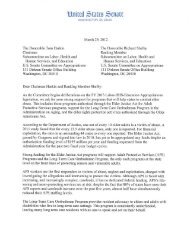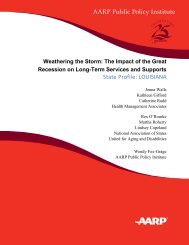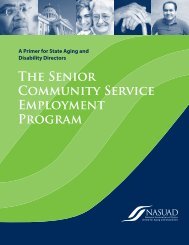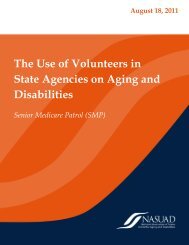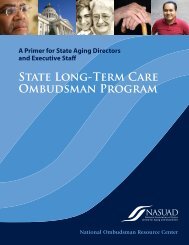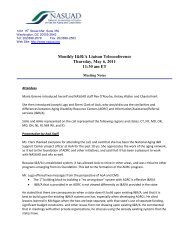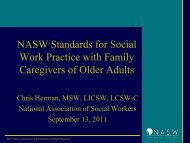Cognitive Adaptation Training - National Association of States ...
Cognitive Adaptation Training - National Association of States ...
Cognitive Adaptation Training - National Association of States ...
Create successful ePaper yourself
Turn your PDF publications into a flip-book with our unique Google optimized e-Paper software.
Texas Money Follows the Person<br />
Demonstration<br />
– Texas’ MFP established in 2001 as a response to the<br />
Olmstead decision. Texas’ federal demonstration<br />
began in 2008.<br />
– Supports individual choice to receive long‐term services<br />
and supports in the community, not the NF… without<br />
being placed on a waiting list.<br />
– Texas leads the nation in the number <strong>of</strong> individuals<br />
relocated under MFP.<br />
– Over 27,000 have left nursing facilities into the<br />
community under the state program and federal<br />
demonstration.
MI in Nursing Facilities<br />
– <strong>National</strong>ly, over 100,000 nursing facility residents have a<br />
primary diagnosis <strong>of</strong> mental illness, with a disproportionate<br />
number (almost 25,000) being under the age <strong>of</strong> 65.<br />
– A 2007 data analysis in Texas nursing facilities residents<br />
showed over 7,000 people were former mental health or<br />
substance abuse clients, and in San Antonio, over 640<br />
nursing facility residents were former clients.<br />
– Because <strong>of</strong> the limitations <strong>of</strong> the public mental health<br />
system in Texas, this data represents a subset <strong>of</strong> all people<br />
with significant behavioral health disorders.<br />
• Bagchi, A.D., Simon, S.E. & Verdier, J.M. (2009). How many nursing home residents live with a mental illness Psychiatric Services,<br />
60(7), 958‐964.<br />
• Texas Department <strong>of</strong> State Health Services and Texas Department <strong>of</strong> Aging and Disability Services (2007). Data match showing<br />
prevalence <strong>of</strong> former DSHS clients in DADS licensed nursing facilities.
Behavioral Health Pilot (BH Pilot)<br />
– One piece <strong>of</strong> the MFP Demonstration. Focuses on<br />
transitioning adults who have mental illness and/or<br />
substance abuse diagnoses in San Antonio and Austin.<br />
– Demonstrates the value / impact <strong>of</strong> providing<br />
behavioral health services to individuals leaving<br />
nursing facilities.<br />
– The BH Pilot adds two additional services to MFP:<br />
<strong>Cognitive</strong> <strong>Adaptation</strong> <strong>Training</strong> and Substance Abuse<br />
Services.
BH Pilot Services—Community Based<br />
– 365 Days <strong>of</strong> Substance Abuse Services<br />
• Community based individual substance abuse<br />
counseling<br />
• Group substance abuse services<br />
• Linkage to other community based services<br />
(Narcotics Anonymous, Alcoholics Anonymous, etc)<br />
• Peer‐Support Specialist<br />
– 365 Days <strong>of</strong> <strong>Cognitive</strong> <strong>Adaptation</strong> <strong>Training</strong> (CAT)<br />
• Empowerment based intervention that helps<br />
participants master skills <strong>of</strong> independent living<br />
• Adapt the persons physical environment to<br />
compensate for disabilities and improve functioning.
BH Pilot Services—Pre‐transition<br />
Services<br />
—6 months <strong>of</strong> Pre‐Discharge Services<br />
• Substance abuse and/or CAT services provided<br />
to participant while s/he is still in the nursing<br />
facility.<br />
• Begin development <strong>of</strong> therapeutic relationship<br />
before the participant relocates.<br />
• CAT services help with the decision making<br />
process <strong>of</strong> choosing the community residence<br />
and tasks necessary to accomplish relocation<br />
(housing voucher paperwork, physically visiting<br />
potential residences)<br />
• Substance abuse counselor works with<br />
participant to identify triggers in the<br />
community for drug or alcohol abuse.
Eligibility<br />
– Must be Medicaid eligible and choose to enroll in<br />
the BH Pilot.<br />
– Must discharge directly from a nursing facility and<br />
have been in an institution for 3 months or more<br />
– Diagnosis <strong>of</strong> severe mental illness or another mental<br />
illness and GAF score < 50<br />
– Wishes to relocate into the community and be able<br />
to benefit from pilot services.
Cross‐Agency Collaboration<br />
– DADS—Runs overall MFP Demonstration.<br />
• STAR+PLUS Support Unit—Meets with participant after s/he<br />
requests community services; enrolls participant in HMO,<br />
contacts relocation contractor.<br />
• Relocation Contractors—Responsible for obtaining and<br />
securing community housing for participants.<br />
– HHSC—Single state agency that administers the Texas Medicaid<br />
Program<br />
• Health Maintenance Organizations (Molina, Superior,<br />
AMERIGROUP, Evercare)—Provide Medicaid managed care<br />
services for participants.<br />
– Department <strong>of</strong> State Health Services—BH Pilot project<br />
management and oversight.<br />
• Center for Healthcare Services—Local Mental Health Authority<br />
in San Antonio. Provides pilot interventions in San Antonio.<br />
• UT Health Science Center—<strong>Training</strong> and technical oversight for<br />
CAT intervention. Also provides CAT Services in Austin.<br />
• Travis County Integral Care— Mental Health Authority in<br />
Austin. Provides substance abuse interventions in Austin.
Findings<br />
• To date, 88% <strong>of</strong> individuals have successful maintained<br />
independence in the community.<br />
• Participants demonstrate statistically significant<br />
improvement on standardized scales (Multinomah<br />
Community Ability Scales) which measure ability to<br />
survive in the community, independence in daily life,<br />
money management and coping skills.<br />
• Preliminary analysis indicates that Medicaid costs for<br />
participants in the Pilot may be lower on average than<br />
costs prior to their discharge from the NF.<br />
• Examples <strong>of</strong> increased independence include getting a<br />
paid job at competitive wages, driving to work,<br />
volunteering, getting a GED, attending computer classes<br />
and working toward a college degree.
<strong>Cognitive</strong> <strong>Adaptation</strong> <strong>Training</strong><br />
Why and How
<strong>Cognitive</strong> Deficits Predict Functional<br />
Outcomes<br />
Executive<br />
Function<br />
Attention<br />
Memory<br />
Performance<br />
<strong>of</strong> ADL’s<br />
Social<br />
Function<br />
Occupational<br />
Function<br />
Green MF. Am J Psychiatry, 1996; 153: 321-330<br />
Velligan et al., Schiz Res, 1997; 25: 21-31
Compensatory Strategies<br />
• Compensatory<br />
strategies rely on<br />
environmental<br />
supports to bypass<br />
cognitive shortcomings<br />
and subsequently<br />
improve functional<br />
outcomes<br />
• CAT – <strong>Cognitive</strong><br />
<strong>Adaptation</strong> <strong>Training</strong><br />
(exs: PDA, post it<br />
notes)<br />
<strong>Cognitive</strong> Processing<br />
(e.g. executive, memory)<br />
Activities <strong>of</strong> Daily Living<br />
Social Functioning<br />
Occupational Functioning<br />
Compensatory<br />
Strategies
Types <strong>of</strong> Compensatory Strategies<br />
• <strong>Cognitive</strong> <strong>Adaptation</strong> <strong>Training</strong> – is an in‐home<br />
intervention to overcome limitations <strong>of</strong> mental illness<br />
with using everyday items/adaptive aids such as<br />
alarms, checklists and the organization <strong>of</strong> belongings.<br />
VS.<br />
• <strong>Cognitive</strong> Remediation –goal is to bolster specific<br />
cognitive capacities that are weak. This treatment is<br />
not typically delivered in the home, but rather is<br />
performed in a group setting within a computer lab.
CAT is based<br />
General<br />
upon level<br />
Intervention<br />
<strong>of</strong> executive functioning<br />
Strategies<br />
and<br />
overt behavior<br />
Apathy<br />
Disinhibition<br />
Mixed<br />
Prompting and cueing to complete each step in a sequenced<br />
task<br />
Removal <strong>of</strong> distracting stimuli and cues for inappropriate<br />
behavior<br />
Both prompting <strong>of</strong> steps and removal <strong>of</strong> distracting stimuli<br />
Fair<br />
Functioning<br />
Poor<br />
Functioning<br />
Cues can be more subtle cues, less proximal<br />
Cues must be larger, more proximal, more numerous<br />
General interventions are then adapted for strengths or<br />
weaknesses in specific areas <strong>of</strong> functioning (e.g. attention,<br />
memory)
1. Frontal Lobe Personality Scale<br />
CAT Assessments<br />
2. Thorough Environmental Assessment with the home<br />
KITCHEN:<br />
Who is responsible for the following jobs<br />
Washing Dishes<br />
Cleaning<br />
Counters/floors<br />
Cooking Food<br />
Shopping<br />
Participant Spouse or Relative Other<br />
a) How <strong>of</strong>ten do you [complete that task] Explain how you go about doing it. What<br />
supplies do you use to complete the job May I see those supplies<br />
b) Can you explain all the steps in making a sandwich to me<br />
c) Give me an example <strong>of</strong> a well‐balanced meal that you can prepare. Describe how<br />
you would prepare it.<br />
d) How do you store leftover food How do you know when it is spoiled<br />
e) Where do you usually eat your meals Who do you usually eat with<br />
f) When eating, what utensils do you use Do you regularly use a napkin (show me<br />
what you use to wipe your mouth)
CAT Intervention Areas<br />
Bathing<br />
Dressing<br />
Dental Hygiene<br />
Make‐up<br />
Work/Vocational Skills<br />
Social Skills, Communication and<br />
Telephone Use<br />
Eating, Nutrition and Cooking<br />
Laundry<br />
Grocery Shopping<br />
Transportation<br />
Leisure Skills<br />
Toileting<br />
Housekeeping/Care <strong>of</strong> Living<br />
Environment<br />
Money Management/Budgeting<br />
Medication Management<br />
Orientation
Basic Interventions/Critical Items
Choose this, not that<br />
Higher functioning (no<br />
alarm) but complicated<br />
medication regimen<br />
Couple with<br />
appropriate med<br />
container for<br />
lower functioning<br />
individual<br />
Low functioning –<br />
alarm and pills<br />
together with voice<br />
alarm. Uncomplicated<br />
medication regimen
Medication<br />
Interventions
Prior to intervention—<br />
Dresser and Drawers
Organization <strong>of</strong> Belongings –<br />
Before and After
Intervention for Dressing<br />
Apathy Disinhibition
Intervention for Safety<br />
Before<br />
After
Daily Activity Log and Instruction Manual
Checklists for everyday behaviors<br />
Take<br />
Morning<br />
Meds<br />
Mario's Daily Checklist<br />
6/11 6/12 6/13 6/14 6/15 6/16 6/17<br />
Wednesday Thursday Friday Saturday Sunday Monday Tuesday<br />
Take Shower<br />
Use<br />
Deoderant<br />
Use Mouth<br />
Wash<br />
Take PM<br />
Meds<br />
Change<br />
Clothes
Dental Hygiene<br />
Brush Teeth<br />
Everyday<br />
Apathy,<br />
Poor Executive<br />
Function
Disinhibition‐‐Fair Executive Function
Use <strong>of</strong> Crisis Response Form<br />
Barbara was discharged from a 3-day psychiatric hospitalization<br />
the day prior to this filming. Within the past three months, she has<br />
been to the hospital almost every week.
Technology in the home<br />
Megan gets an idea during the session for a sign
Intervention for smoking
Outcome Assessments<br />
Assessments are completed at the time <strong>of</strong> relocation and each 3<br />
months:<br />
•The Multnomah Community Ability Scale (MCAS) is a 17‐item<br />
scale assessing domains <strong>of</strong> functionality including interference<br />
with functioning, adjustment to living, social competence, and<br />
behavioral problems (Barker et al., 1994). The MCAS generates a<br />
total score and scores for each <strong>of</strong> the five domains listed above,<br />
with higher scores indicating better functioning.<br />
•The Life Skills Pr<strong>of</strong>ile (LSP) measures aspects <strong>of</strong> functioning<br />
(“life skills”) which affect how successfully people with mental<br />
illness live in the community or hospital (Rosen et al.1989). The 5<br />
subscales include self‐care, non‐turbulence and social contact,<br />
communication and responsibility.
Preliminary Results<br />
Design: 67 persons with a major DSM‐IV Axis I Diagnosis<br />
and comorbid physical illness(es) were relocated into the<br />
community and, at the time <strong>of</strong> analyses, 44 <strong>of</strong> those had at<br />
least one follow‐up rating. Behavioral health diagnoses<br />
primarily include depression, dementia, bipolar disorder,<br />
schizophrenia, and substance abuse disorders. Age <strong>of</strong><br />
participants ranged from 27‐89, with an average age <strong>of</strong> 56.7.<br />
In a mixed model analyses <strong>of</strong> covariance between baseline<br />
and follow‐up scores, results indicate the total MCAS score<br />
increased (F=2.7, p
Results Cont’d<br />
•Individual MCAS item scores<br />
appear in the Table. All individual<br />
items improved (several<br />
significantly) with the exception <strong>of</strong><br />
physical health impairment, which<br />
is significantly poorer at follow‐up.<br />
•On the LSP, no significant changes<br />
in either direction were apparent in<br />
the total score nor in 5 <strong>of</strong> the<br />
subscales. A significant<br />
improvement in communication<br />
was found (F= 3.44, p
Discussion<br />
•CAT was successfully applied to persons with comorbid<br />
mental and physical disorders relocating from nursing<br />
facilities to independent living environments with good<br />
preliminary outcomes indicating better overall community<br />
functioning. The majority <strong>of</strong> persons have successfully<br />
remained in the community. However, poorer scores are<br />
seen on follow‐up physical health outcomes.<br />
•Involvement in social activities did not improve post NF<br />
discharge. This is likely due to the variety <strong>of</strong> social<br />
activities/persons available at the NF while these<br />
activities/persons must be sought out in independent<br />
living.<br />
•The pilot will continue into 2016. If it continues to be<br />
successful it will be considered for inclusion in the Texas<br />
Medicaid long term services and support system.
“Ode to a fragile flower”<br />
Barbara visited the<br />
Yucatan Peninsula many<br />
years ago and saw a flower<br />
growing all on its own in<br />
the midst <strong>of</strong> nothing else.<br />
This flower reminds her <strong>of</strong><br />
how she “sprung forth” out<br />
<strong>of</strong> the nursing facility to<br />
thrive.
“Independence”<br />
Natalie demonstrates<br />
“reaching for the<br />
stars” in her depiction<br />
<strong>of</strong> independence. She<br />
includes the airplane<br />
to reflect that she now<br />
feels she can travel<br />
throughout Texas, the<br />
United <strong>States</strong> and<br />
beyond.
Untitled<br />
Hallie’s favorite features in her watercolor <strong>of</strong> independent living<br />
include her sports car and brightly colored homes.
Questions





